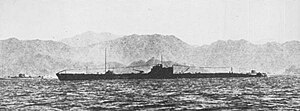
Back I-175 Spanish I-75 (sous-marin, 1937) French I-175 Italian 伊号第百七十五潜水艦 Japanese I-75/I-175 Ukrainian I-175 (tàu ngầm Nhật) Vietnamese
 I-75 in late October 1941.
| |
| History | |
|---|---|
| Name | I-75 |
| Ordered | 1934 |
| Builder | Mitsubishi Heavy Industries, Kobe, Japan |
| Laid down | 1 November 1934 |
| Launched | 16 September 1937 |
| Commissioned | 8 December 1938 |
| Renamed | I-175 on 20 May 1942 |
| Fate | Sunk 4 February 1944 |
| Stricken | 10 July 1944 |
| General characteristics | |
| Class and type | Kaidai type (KD6B Type) |
| Displacement |
|
| Length | 105 m (344 ft 6 in) |
| Beam | 8.2 m (26 ft 11 in) |
| Draft | 4.57 m (15 ft 0 in) |
| Installed power |
|
| Propulsion | |
| Speed |
|
| Range |
|
| Test depth | 75 m (246 ft) |
| Complement | 70 |
| Armament |
|
I-75, later I-175, was an Imperial Japanese Navy Kaidai-type cruiser submarine of the KD6B sub-class commissioned in 1938. During World War II, she took part in the attack on Pearl Harbor, the Battle of Midway, the Guadalcanal campaign, the Aleutian Islands campaign, and the Gilbert and Marshall Islands campaign and operated off Australia, before she was sunk in 1944 during her tenth war patrol. She is best known for sinking the United States Navy escort carrier USS Liscome Bay on 24 November 1943.
© MMXXIII Rich X Search. We shall prevail. All rights reserved. Rich X Search